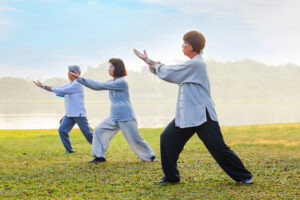
New findings about Tai Chi and Blood Pressure have recently been published in the journal JAMA Network Open.
There is a large body of research pointing to the health benefits of Tai Chi. Regular practitioners are aware that the combination of slow, gentle movements help to increase flexibility and improve balance. As ‘meditation in motion‘ the calming effects of Tai Chi are also well documented. Now, new research suggests it’s better than more vigorous aerobic exercises for lowering blood pressure in people with prehypertension.
Prehypertension is blood pressure that’s higher than normal but doesn’t quite reach the level of high blood pressure, or hypertension. It’s considered a warning sign that heart disease may be ahead, and it raises the risk of having a heart attack.
The latest research
In this study, researchers in China randomly assigned 342 adults with prehypertension to one of two interventions. The average age of participants was 49. Roughly half the people participated in supervised aerobic exercise, including jogging, climbing stairs, brisk walking and cycling. The other half was trained to practice tai chi. Both groups got hourlong sessions four times a week.
After 12 months, those in the tai chi group saw bigger drops in their blood pressure than those in the aerobic exercise group. What’s more, nearly 22% of the people who practiced tai chi saw their blood pressure fall to within normal range, compared with nearly 16% of people in the aerobic exercise group. And fewer patients in the tai chi group went on to develop hypertension than in the aerobic exercise group.
Previous research had also found that Tai Chi is more effective than brisk walking at lowering blood pressure, fasting blood sugar levels and perceived stress in people who have hypertension.
Another study indicated that a more than 12 weeks Tai Chi exercise cycle with less than 60 min each time and more than 5 times per week may be particularly beneficial in blood pressure reduction
Why is that?
According to Professor Ruth Taylor-Pillae, at the University of Arizona’s College of Nursing, the practice tends to elicit more of a response from the parasympathetic nervous system. This is the network of nerves that relaxes your body after periods of stress or danger.
Professor Taylor-Pillae was not connected with the study. Her own research focuses on how mind-body interventions can benefit older adults with cardiovascular disease. She believes it is the meditative quality of Tai Chi that works towards lowering blood pressure. “It …. helps to just relax everything”. The Professor notes a large body of evidence has now shown the benefits of tai chi on blood pressure, but offers this caveat about regular and consistent practice to get the benefits. “You have to have enough ‘dose’ of tai chi, you can’t just do it one hour, one time.”
The appeal of Tai Chi
Tai Chi is appealing to many as a form of exercise because it is low impact and requires little space or equipment. You don’t have to go to a gym and you don’t need special clothing. It’s best to learn Tai Chi with a knowledgeable teacher, but you can practice anytime, anywhere.
As well as providing that calming, relaxing effect that is so beneficial for blood pressure, Tai Chi can help reduce the risk of falls. It helps to improve balance and walking speed in older adults, as well as reducing depression and anxiety. Evidence suggests it can also help protect against cognitive decline and even boost memory.
But you have to practice it consistently to reap the most benefit.
